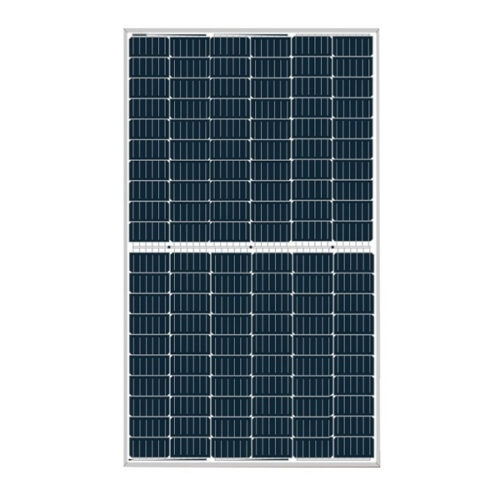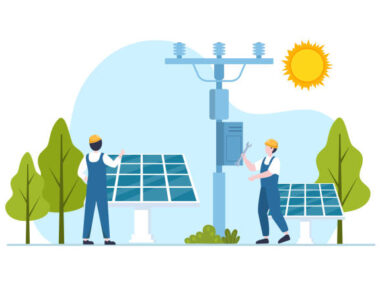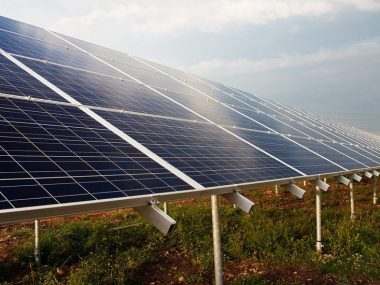WHAT IS SOLAR ENERGY PANEL?
Solar energy panels is a device that converts sunlight into electricity by using (PV) cell. PV cells are made of materials that produce excited. Solar panels are usually made of silicon, or another semiconductor materials installed in a matal panel frame with a class casing. When this materials is exposed to photons of sunlight (very small packet of energy) It release electrons and produces electric charge.
When sunlight hits a solar panel, it excites the electrons in the solar cells, creating an electric current. This direct current (DC) electricity is then collected by the wiring within the panel and can be used to power electrical devices directly, stored in batteries for later use, or converted into alternating current (AC) electricity using a solar inverter for use in homes, businesses, or the electrical grid.
WHAT ARE THE BEST SOLAR ENERGY PANELS?
Checking or asking of the best solar panel depends on the the high quality and the cost of panel. With good efficiency, longer lifespans and higher output solar panels from the following 5 factors will rise your money.
1 SUNPOWER;
Number one solar company.
Sunpower is the number one among all solar company and with 37 years of consistency in solar ideas.
Sunpower’s M-seriesSunPower’s M-Series 440 W solar panels offer the most power at 21.2 watts (W) per square foot. They’re highly efficient and come with a great warranty, which covers your entire system (the panels, inverters, and racking equipment). The biggest downside of SunPower panels is the price. They’re the most expensive brand on our list, with at least a $4K premium compared to the average 10 kilowatt (kW) solar panel system. We recommend considering SunPower panels if you have limited roof space or significant shading. Otherwise, you may be better off with a slightly lower performance but more cost-effective option.
2 REC.
Number one in warm climates
REC is a European-based solar company that offers a range of solar panels. Its newest series, the Alpha pure –R, has an impressive temperature coefficient compared to other to panels at 0.24%/0C, making them the best choice, if you live in a consistently hot environment. The Alpha Pure-R panels on our list at 22.3% efficiency.
3 MAXEON SOLAR TECHNOLOGIES
Best warranty
As we said before, in efficiency and power-dense m-series solar panels, maxeon is the company behind sunpower. Maxeon offers an industry-leading warranty, quaranteeing its solar panels will produce 88.25% of their original output at year 40. That’s 15 years longer than traditional solar performance warranties. Maxeon own line of solar panels doesn’t perform quite as well as sunpower’s but its panels cost about 9% less. Its optimistic that maxeon will start offering the highest performance panels once their exculsive relationship with sunpower taminate by April.
4Panasonic
Number one in roofing with tight spaces
Panasonic is most commonly known in the U.S and other part of the globe as a TV and small appliance manufacturer, but the Japanese company is also a global leader in solar panels. In 2021, Panasonic began outsourcing its solar panel manufacturing to third-party companies, but panels with Panasonic’s name on them continue to uphold the same standards for quality workmanship and high efficiency. They also still include 20 to 25 years warranty. Panasonic panels are the smallest on our list at just 19.9 sq ft, making them a great choice if you have an awkward roof with tight spaces.
5 Jinko Solar
Best performance per penny
Jinko Solar may have the lowest power per square foot of the top five panels on these list, but in term of cost, they offer the best value in the market. At over 22% efficiency for their highest quality panels and an average cost of $2.55/W, Jinko panels are a great deal. Just keep in mind that they’re a bit larger than the other panels, they might not really perfect as well for installations on smaller or tiny roofs
Characteristics of solar power panels
Solar panel is one of the most importance factor in the solar power generation system. Its function is to convert the sun’s light energy into electrical energy, and then output DC power to be stored in the battery. The conversion rate and service life are importance factors that determine whether the solar cell has use value .36 or 72 polycrystalline silicon solar cells connected in series to form various types of components of 12v and 24v. The module can be use in various household photovoltaic system, independent photovoltaic power plants and grid-connected photovoltaic power plants.
Cells are packaged with high-efficiency (above 16.5) monocrystalline silicon solar cells to ensure sufficient power generation of solar panels. The glass is made of low-iron tempered suede glass (also known as white glass) which has a light transmittance of more than 91% in the wavelength range of solar cell’s spectral response, and a high reflectance for infrared light than 1200nm.
How does solar energy work in a remote area
- What is remote solar energy?
Remote and off-grid solar systems provide energy opportunities to areas in which traditional power lines do not pass through. This may be because traditional power lines are too expensive or none accessible, or they are simply impractical to construct within the given area. The main component of a remote solar panel system is the solar panels which produce a certain amount of power depending on their specifications such their as voltage and wattage. How do solar panels work? Solar energy is a clean and renewable energy source which comes from the sun. It can be harnessed and converted into useable energy through the use of photovoltaics. Incoming sunlight hits a semiconductor material that is used within a solar panel and knocks electrons loose. When these electrons are set in motion, they generate an electric current that can be captured. This current is then converted by the solar inverter into the type of electricity that can be used within the electric grid.
What are the benefits of using solar energy in remote areas
Improved access to electricity: Solar energy can provide electricity to remote areas that are not connected to the grid or have unreliable power supply. Solar panels can be installed on rooftops, poles, or ground-mounted structures to capture sunlight and convert it into electricity that can be used directly or stored in batteries for later use. Solar energy can also be used to power microgrids that can serve multiple.
Improved health and safety: Solar energy can improve the health and safety of rural communities by reducing indoor air pollution, which is a major cause of respiratory diseases, especially among women and children who spend a lot of time indoors. Solar energy can also provide reliable lighting for schools, clinics, and homes, which can enhance security, reduce accidents, and extend productive hours.
Cost Savings; Solar panels can also offer cost savings in remote locations. While the initial investment in solar panels may seem high, the long-term savings can be substantial. Once installed, solar panels require minimal maintenance, reducing the need for ongoing expenses. Additionally, the cost of transporting fuel to remote locations can be high, making solar panels a more cost-effective solution in the long run.
Versatility; Solar panels are highly adaptable and can be used in a range of applications. They can be used to power homes, water pumps, lighting, and communication systems, among other things. Additionally, solar panels can be installed in a variety of locations and terrains, making them a flexible solution in remote areas. This versatility means that solar panels can provide energy solutions to a range of needs and applications
Enhanced education and communication: Solar energy can enhance education and communication by powering computers, internet routers, and mobile phones. Solar energy can also provide access to e-learning, e-health, and e-commerce platforms, which can expand the horizons of rural communities and connect them to the global knowledge economy
Sustainable development: Solar energy can contribute to sustainable development by reducing the carbon footprint of rural communities and promoting the use of clean technologies. Solar energy can also create local jobs in manufacturing, installation, maintenance, and entrepreneurship. Moreover, solar energy can empower women and youth by providing them with skills, assets, and opportunities to participate in the energy value chain.











